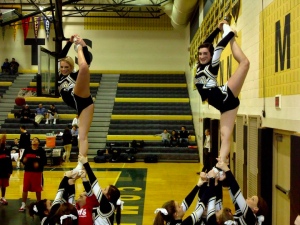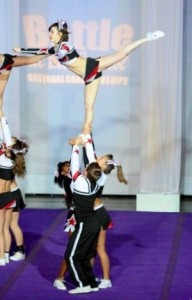By Maggie Dubbs –
Most people don’t considering standing on the sidelines a sport.
But cheerleading has been a part of universities since 1880. This “sport” started at Princeton University on the sidelines at football games to encourage spirit. It has since then trended over to high school and now is be coming an all star sport for competition.
But how does this “sport” compare to the other endeavors athletes endure?

People say it doesn’t even compare to the amount of work that other athletes put in, from early morning conditioning at 6:15 to late night practices around 8:30.
Cheerleading practice, some say, is just a bunch of girls jumping around yelling.
But consider this -cheerleading has had more and more injuries over the years. According to CPSC, “in 2007, head and neck injuries accounted for 15.1 percent of total cheerleading injuries. In 2006, head injuries were associated with 1,070 concussions, 200 contusions, 15 fractures and 1,157 internal injuries; neck injuries accounted for 79 contusions, 60 fractures and 1,325 sprains/strains. In 2007, head injuries were associated with 783 concussions, 308 contusions, 69 lacerations and 1,122 internal injuries; neck injuries were associated with 303 contusions, 5 fractures and 1,281 sprains/strains.”
According to Momsteam.com “Football has between 600,000 and 760,000, in high school, concussions.”
Yes, football has more concussions over all, but it seems as though cheerleading is somehow more dangerous with different injuries.
Many sports including boy’s and girl’s lacrosse, girl’s basketball and boy’s and girl’s volleyball have the school trainer working them out and pushing them to extreme limits using their muscles. Cheerleaders lift maybe 90 to 100 pound girls, and of course with the assistance of two other team mates.
All sports have mandatory practices during the season when they are not performing on the fields or courts. Cheering only occurs two to three times a week and preseason practices are even less.
But, the amount of time put into other varsity sports is no where near the amount of time cheerleaders put into their routines and the learning of their cheers is even less.
“Cheerleading is a sport, because we go to the weight room, and stay in shape just like all of the other teams do,” said cheerleader of three years, Jessica Hanner.

Just because cheerleader goes to the weight room, doesn’t mean they have set routines while lifting.
“We’re kind of allowed to do whatever we want, we mostly just do abs,” said Mackenzie Payne, cheerleader of 11 years.
Payne was also apart of All-Star Elite cheerleading.
“Cheerleading is cheerleading, either way I’m having fun,” said Payne.
All-Star cheerleading should be considered a sport, because those gymnasts are actually in the gym. Usually the girls and or guys, six out of seven days of the week, for many hours are training very hard to place well in competitions coming up.
“All-star cheerleading is more extreme than high school because you have to be in tip-top shape. All-Star practice was three hours, six days a week, where as high school is like two hours for three days out of the week. We don’t do stunts like All-Stars do,” said Payne.

As long as they’re on the sidelines, they’ll never cross the line of sport-hood. They’re more like supporting athletes than real athletes.
All-Star Cheerleading Cheerleaders do flips, twists and difficult stunts. Yes, they deserve credit for something most people can’t do, but it’s nothing an Olympic gymnast couldn’t do.
Some sports that get cheered for find it annoying.
“Sometimes, yeah they’re annoying because you’re trying to concentrate, and they’re just yelling and carrying on, but sometimes it’s nice to have something to look at,” said varsity wrestler Mac Evarts.